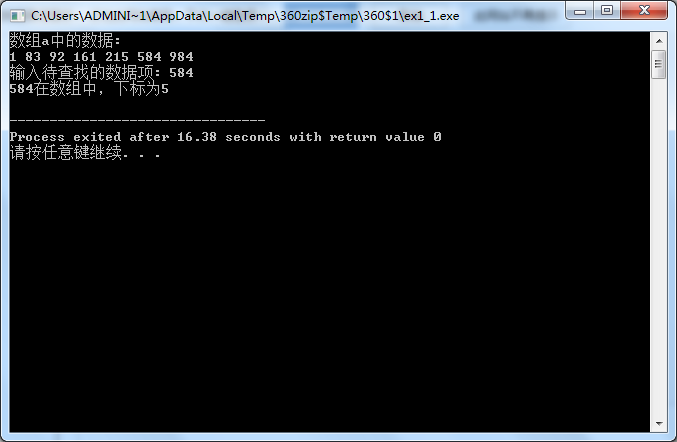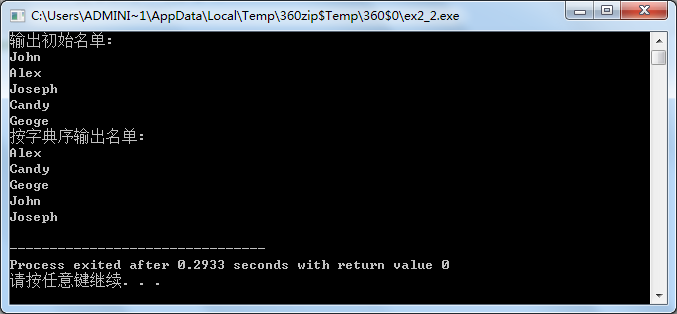实验结论
1.二分查找
ex1_1
1 // 练习:使用二分查找,在一组有序元素中查找数据项 2 // 形参是数组,实参是数组名 3 #include <stdio.h> 4 const int N=7; 5 int binarySearch(int x[], int n, int item); 6 int main() { 7 int a[N]={1,83,92,161,215,584,984}; 8 int i,index, key; 9 10 printf("数组a中的数据:\n"); 11 for(i=0;i<N;i++) 12 printf("%d ",a[i]); 13 printf("\n"); 14 15 printf("输入待查找的数据项: "); 16 scanf("%d", &key); 17 18 index=binarySearch(a,N,key);// 调用函数binarySearch()在数组a中查找指定数据项item,并返回查找结果给index 19 20 if(index>=0) 21 printf("%d在数组中,下标为%d\n", key, index); 22 else 23 printf("%d不在数组中\n", key); 24 25 return 0; 26 } 27 28 29 //函数功能描述: 30 //使用二分查找算法在数组x中查找特定值item,数组x大小为n 31 // 如果找到,返回其下标 32 // 如果没找到,返回-1 33 int binarySearch(int x[], int n, int item) { 34 int low, high, mid; 35 36 low = 0; 37 high = n-1; 38 39 while(low <= high) { 40 mid = (low+high)/2; 41 42 if (item == x[mid]) 43 return mid; 44 else if(item<x[mid])/*补足代码②*/ 45 high = mid - 1; 46 else 47 low = mid + 1; 48 } 49 50 return -1; 51 }

ex1_2
1 // 练习:使用二分查找,在一组有序元素中查找数据项 2 // 形参是指针变量,实参是数组名 3 #include <stdio.h> 4 const int N=5; 5 int binarySearch(int *x, int n, int item); 6 int main() { 7 int a[N]={1,3,9,16,21}; 8 int i,index, key; 9 10 printf("数组a中的数据:\n"); 11 for(i=0;i<N;i++) 12 printf("%d ",a[i]); 13 printf("\n"); 14 15 printf("输入待查找的数据项: "); 16 scanf("%d", &key); 17 18 index=binarySearch(a,N,key); // 调用函数binarySearch()在数组a中查找指定数据项item,并返回查找结果 19 20 if(index>=0) 21 printf("%d在数组中,下标为%d\n", key, index); 22 else 23 printf("%d不在数组中\n", key); 24 25 return 0; 26 } 27 28 //函数功能描述: 29 //使用二分查找算法在x指向的数据项开始的n个数据中,查找item 30 // 如果找到,返回其位置 31 // 如果没找到,返回-1 32 int binarySearch(int *x, int n, int item) { 33 int low, high, mid; 34 35 low = 0; 36 high = n-1; 37 38 while(low <= high) { 39 mid = (low+high)/2; 40 41 if (item == *(x+mid)) 42 return mid; 43 else if(item<*(x+mid)/*补足代码②*/) 44 high = mid - 1; 45 else 46 low = mid + 1; 47 } 48 49 return -1; 50 }

2.选择法排序
ex2-2
1 // 练习:使用选择法对字符串按字典序排序 2 #include <stdio.h> 3 #include <string.h> 4 void selectSort(char str[][20], int n ); // 函数声明,形参str是二维数组名 5 int main() { 6 char name[][20] = {"John", "Alex", "Joseph", "Candy", "Geoge"}; 7 int i; 8 9 printf("输出初始名单:\n"); 10 for(i=0; i<5; i++) 11 printf("%s\n", name[i]); 12 13 selectSort(name, 5); // 调用选择法对name数组中的字符串排序 14 15 printf("按字典序输出名单:\n"); 16 for(i=0; i<5; i++) 17 printf("%s\n", name[i]); 18 19 return 0; 20 } 21 22 // 函数定义 23 // 函数功能描述:使用选择法对二维数组str中的n个字符串按字典序排序 24 void selectSort(char str[][20], int n) { 25 char ch1,min,ch3,*temp; 26 for(ch1=0;ch1<n-1;ch1++){ 27 min=ch1; 28 for(ch3=ch1+1;ch3<n;ch3++) 29 if(strcmp(str[ch3],str[min])<0){ 30 min=ch3; 31 } 32 if(min!=ch1){ 33 strcpy(temp,str[ch1]); 34 strcpy(str[ch1],str[min]); 35 strcpy(str[min],temp); 36 } 37 38 39 } 40 41 42 }


这个实验与整数排序方法一致,因此只需参考ex2-1的算法很容易就能写出来,但要注意字符串的比较和赋值必须借助函数完成!
3.用指针处理字符串
是直接使用的老师写好的代码
总结
1.二分查找中,数据需满足
(1) 顺序储存
(2)元素有序
如由大到小排序,或由小到大排序
2. 形参:数组名,需带[ ],如 void delMiddleStar(char s[ ])
函数声明中,变量名可省略,如 void delPrefixStar(char [ ])
实参:数组 无[ ],如 index=binarySearch(a,N,key)中的 a 为数组
3.字符串的比较,赋值等操作,不能直接使用关系运算符和赋值运算符,要借助字符串处理函数
如 字符串的比较使用 strcmp( , )
赋值使用 strcpy( , )
需予以注意,很容易因为习惯出错




 浙公网安备 33010602011771号
浙公网安备 33010602011771号